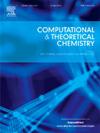探讨三苯胺基小分子受体片段设计对增强钙钛矿太阳能电池光伏性能的影响
IF 3
3区 化学
Q3 CHEMISTRY, PHYSICAL
引用次数: 0
摘要
光伏器件,特别是钙钛矿太阳能电池(PSCs),在满足世界日益增长的能源需求方面显示出巨大的潜力。在这项研究中,我们设计了基于三苯胺的五孔传输材料(HTMs),即PM1, pmm2, PM3, PM4和PM5。我们的研究结果表明,PM1-PM5 HTMs比参考PR具有更多的负HOMO能、低结合能、高电荷转移流和更好的溶解度,从而提高了psc的性能。总电荷转移量(1.39 ~ 1.86 e)、空穴跳变率(8.19 × 1013 ~ 1.14 × 1014 s−1)、空穴重组能(0.2887 ~ 0.3112 eV)和空穴转移积分(0.2181 ~ 0.2539 eV)的结果表明,pm1 ~ pm5 HTMs具有优越的PSCs空穴转移势。电子激发分析表明,与参考HTM相比,PM1-PM5 HTM具有更强的激子解离、更好的空穴产生、低耦合、高光电流密度和更好的电荷转移。此外,PM1-PM5 HTM的开路电压高于PR HTM,显示出在高效psc中用作新型HTM的有趣潜力。因此,我们的显著结果表明,我们的研究将说明PM1-PM5 HTMs在为太阳能行业制造高效psc方面的潜力。本文章由计算机程序翻译,如有差异,请以英文原文为准。

“Probing the effect of acceptor moiety design in triphenylamine-based small molecules for enhancing the photovoltaic properties of perovskite solar cells”
Photovoltaic devices, particularly perovskite solar cells (PSCs), show great potential for meeting the world's growing energy needs. In this study, we have designed triphenylamine-based five hole-transporting materials (HTMs), namely PM1, PM2, PM3, PM4, and PM5 for PSCs. Our findings show that PM1-PM5 HTMs have more negative HOMO energies, low binding energies, high charge transfer flow, and superior solubility than the reference PR, which improves the performance of PSCs. The results of total amount of charge transfer (1.39 to 1.86 e), hole hopping rate (8.19 × 1013 to 1.14 × 1014 s−1), hole reorganization energy (0.2887 to 0.3112 eV), and hole transfer integral (0.2181 to 0.2539 eV) showed that PM1-PM5 HTMs have superior hole transport potential for PSCs. The electronic excitation analyses indicated that PM1-PM5 HTMs have stronger exciton dissociation, superior hole generation, low coupling, high photocurrent density, and superior charge transfer than the reference HTM. Moreover, the open-circuit voltage of PM1-PM5 HTMs is higher than the PR HTM, demonstrating the intriguing potential to be used as novel HTMs in efficient PSCs. Thus, our remarkable results indicated that our investigations will illustrate the potential of PM1-PM5 HTMs in manufacturing efficient PSCs for the solar industry.
求助全文
通过发布文献求助,成功后即可免费获取论文全文。
去求助
来源期刊

Computational and Theoretical Chemistry
CHEMISTRY, PHYSICAL-
CiteScore
4.20
自引率
10.70%
发文量
331
审稿时长
31 days
期刊介绍:
Computational and Theoretical Chemistry publishes high quality, original reports of significance in computational and theoretical chemistry including those that deal with problems of structure, properties, energetics, weak interactions, reaction mechanisms, catalysis, and reaction rates involving atoms, molecules, clusters, surfaces, and bulk matter.
 求助内容:
求助内容: 应助结果提醒方式:
应助结果提醒方式:


